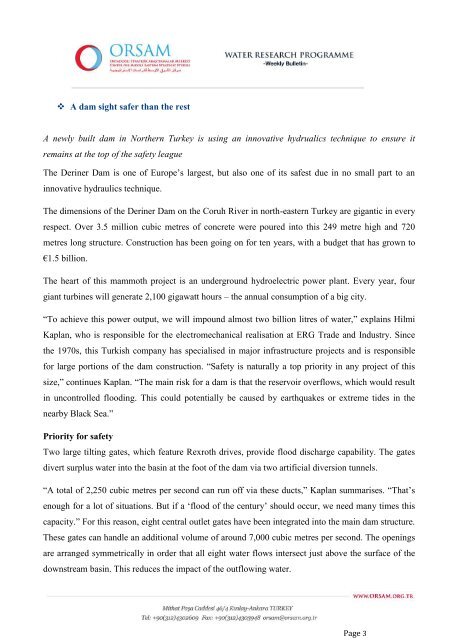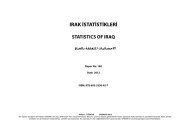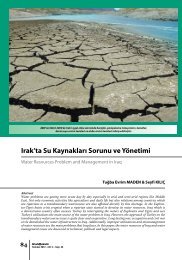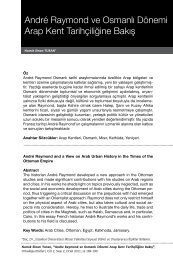29 April -05 May 2013 - orsam
29 April -05 May 2013 - orsam
29 April -05 May 2013 - orsam
You also want an ePaper? Increase the reach of your titles
YUMPU automatically turns print PDFs into web optimized ePapers that Google loves.
A dam sight safer than the rest<br />
A newly built dam in Northern Turkey is using an innovative hydrualics technique to ensure it<br />
remains at the top of the safety league<br />
The Deriner Dam is one of Europe‘s largest, but also one of its safest due in no small part to an<br />
innovative hydraulics technique.<br />
The dimensions of the Deriner Dam on the Coruh River in north-eastern Turkey are gigantic in every<br />
respect. Over 3.5 million cubic metres of concrete were poured into this 249 metre high and 720<br />
metres long structure. Construction has been going on for ten years, with a budget that has grown to<br />
€1.5 billion.<br />
The heart of this mammoth project is an underground hydroelectric power plant. Every year, four<br />
giant turbines will generate 2,100 gigawatt hours – the annual consumption of a big city.<br />
―To achieve this power output, we will impound almost two billion litres of water,‖ explains Hilmi<br />
Kaplan, who is responsible for the electromechanical realisation at ERG Trade and Industry. Since<br />
the 1970s, this Turkish company has specialised in major infrastructure projects and is responsible<br />
for large portions of the dam construction. ―Safety is naturally a top priority in any project of this<br />
size,‖ continues Kaplan. ―The main risk for a dam is that the reservoir overflows, which would result<br />
in uncontrolled flooding. This could potentially be caused by earthquakes or extreme tides in the<br />
nearby Black Sea.‖<br />
Priority for safety<br />
Two large tilting gates, which feature Rexroth drives, provide flood discharge capability. The gates<br />
divert surplus water into the basin at the foot of the dam via two artificial diversion tunnels.<br />
―A total of 2,250 cubic metres per second can run off via these ducts,‖ Kaplan summarises. ―That‘s<br />
enough for a lot of situations. But if a ‗flood of the century‘ should occur, we need many times this<br />
capacity.‖ For this reason, eight central outlet gates have been integrated into the main dam structure.<br />
These gates can handle an additional volume of around 7,000 cubic metres per second. The openings<br />
are arranged symmetrically in order that all eight water flows intersect just above the surface of the<br />
downstream basin. This reduces the impact of the outflowing water.<br />
Page 3
















